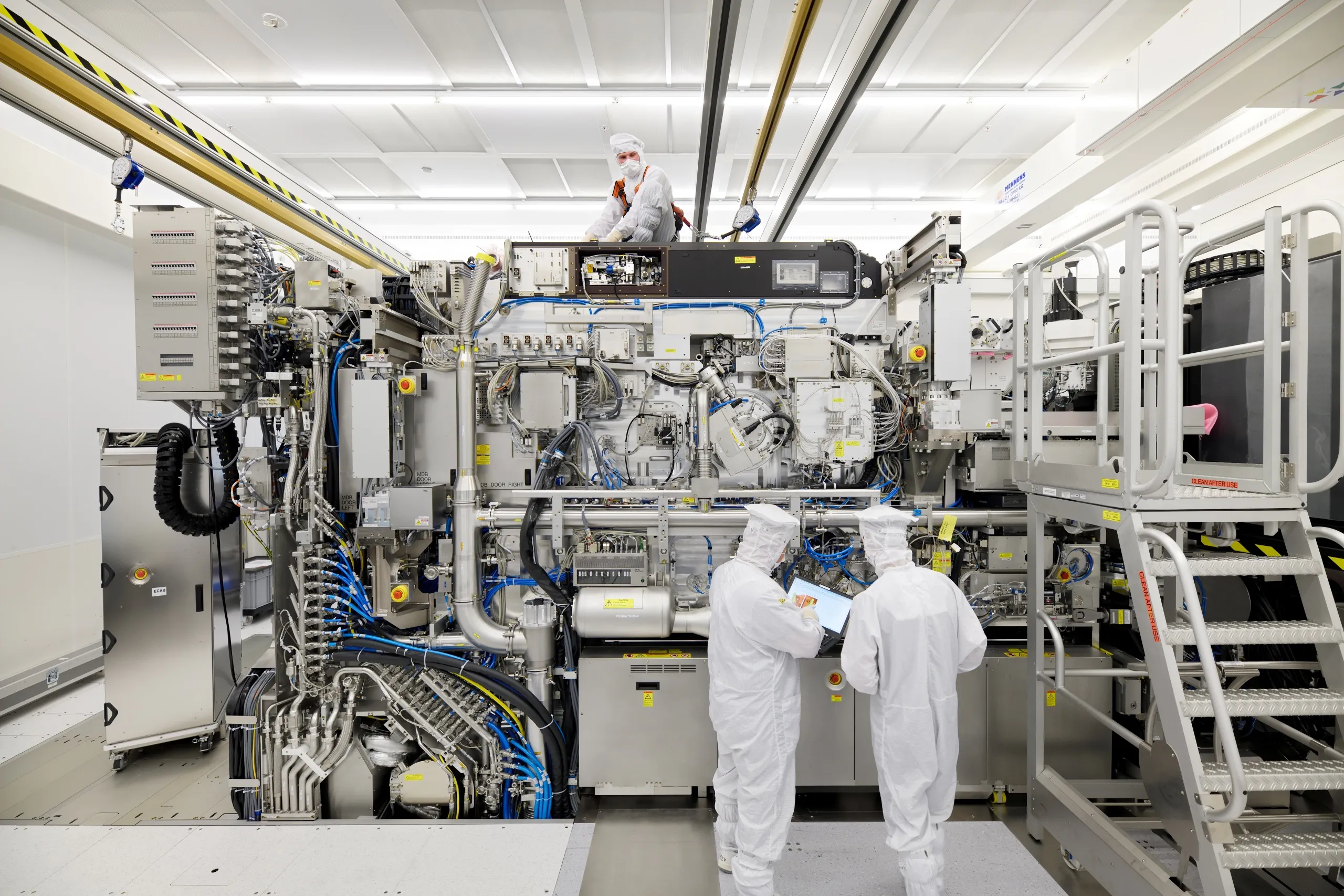
An extreme ultraviolet lithography machine is a technological marvel. A generator ejects 50,000 tiny droplets of molten tin per second. A high-powered laser blasts each droplet twice. The first shapes the tiny tin, so the second can vaporize it into plasma. The plasma emits extreme ultraviolet (EUV) radiation that is focused into a beam and bounced through a series of mirrors. The mirrors are so smooth that if expanded to the size of Germany they would not have a bump higher than a millimeter. Finally, the EUV beam hits a silicon wafer—itself a marvel of materials science—with a precision equivalent to shooting an arrow from Earth to hit an apple placed on the moon. This allows the EUV machine to draw transistors into the wafer with features measuring only five nanometers—approximately the length your fingernail grows in five seconds. This wafer with billions or trillions of transistors is eventually made into computer chips.
An EUV machine is made of more than 100,000 parts, costs approximately $120 million, and is shipped in 40 freight containers. There are only several dozen of them on Earth and approximately two years’ worth of back orders for more. It might seem unintuitive that the demand for a $120 million tool far outstrips supply, but only one company can make them. It’s a Dutch company called ASML, which nearly exclusively makes lithography machines for chip manufacturing. Despite this hyperspecialization, it has a market capitalization of more than $150 billion dollars—much higher than IBM’s and only slightly lower than Tesla’s.
EUV lithography technology has been in development since the 1980s but entered mass production only in the last two years. Other companies make older generations of lithography machines that don’t use EUV and can only make older generations of less cost-effective chips. These companies include venerable firms such as Nikon and Canon. They have the experience, expertise, and market discipline that comes from decades of profitability in a competitive industry under extreme technological demands. If these companies could make EUV machines, they would—it would make them billions of dollars. This is also why, after more than 30 years of development and billions of dollars in R&D, ASML still faces such a backlog of orders: They are hard to make. EUV machines are at the frontier of human technological capabilities.
China has virtually no lithography experience or industry. Any Chinese firm trying to develop EUV lithography would have to start from scratch. It would have to close the gap with ASML’s billions of dollars, decades of experience, and the accumulated experience and tacit knowledge of their tens of thousands of employees. And it would have to succeed where experienced, billion-dollar companies failed. There is little chance a Chinese company will make an EUV lithography machine in the foreseeable future.
Recognizing the strategic importance of EUV machines, and under pressure from the United States, in November 2019, the Dutch government prevented ASML from shipping an EUV machine to China. Related news coverage painted ASML as a pawn in the U.S.-China trade war, but the Dutch decision was about so much more. There are many strategically important technologies in the development pipeline that are potentially dangerous or destabilizing. They include artificial intelligence, autonomous weapons systems, hypersonic missiles, cyberweapons, surveillance tools, and the latest generation of nuclear weapons. These technologies, and many others, require state-of-the-art chips to develop and deploy. Keeping these chips away from the Chinese government, or those acting on its behalf, can pre-empt many worst-case human rights and security scenarios in the coming decades. The Chinese government cannot engage in techno-authoritarianism or arms races if it lacks advanced chips.
Trade between the United States and China has made both countries wealthier, but the United States has always recognized that some objects are too dangerous to trade freely. The opening of China and rising prosperity of its citizens over the last four decades has been one of the most important developments in the last century, lifting nearly a billion people out of poverty. Any export controls the United States and its allies impose should be as narrow as possible, targeting only technologies and users that undermine international security or human rights.
We can accomplish this aim with a two-part export control plan. First, the United States, the Netherlands, and Japan should impose strict multilateral export controls on the manufacturing equipment—including EUV lithography machines—needed to produce advanced chips. These three countries monopolize chip manufacturing equipment chokepoints with technical barriers to entry similar to that posed by EUV lithography. Targeted export controls will maintain China’s dependence on imports for advanced chips. Second, the United States, Taiwan, and South Korea—the three countries whose firms manufacture advanced chips—should impose narrow multilateral export controls on chips. These controls should narrowly target specific end-users, like the Chinese government, and end-uses, like surveillance. They should allow the large majority of Chinese users to import the chips for commercial use.
In this respect, EUV machines are even more than technological marvels: they offer important avenues for progress. By advancing computer chip technology, they advance frontiers in science and engineering and increase global prosperity. Keeping these machines in the hands of democracies could help sustain this march of progress and prosperity for decades to come.
Carrick Flynn is a research fellow at Georgetown’s Center for Security and Emerging Technology and a research affiliate with Centre for the Governance of AI at the University of Oxford, where he was the founding assistant director.
"machine" - Google News
July 01, 2020 at 04:59AM
https://ift.tt/2VyvmS9
The chip-making machine at the center of Chinese dual-use concerns - Brookings Institution
"machine" - Google News
https://ift.tt/2VUJ7uS
https://ift.tt/2SvsFPt
Bagikan Berita Ini














0 Response to "The chip-making machine at the center of Chinese dual-use concerns - Brookings Institution"
Post a Comment